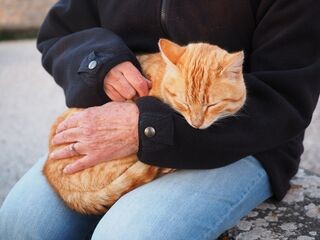It’s a common observation among cat lovers: orange cats, with their striking ginger coats, often seem to possess a uniquely vibrant and sometimes, well, “crazy” personality. But is there any truth behind this feline stereotype? While the term “crazy” might be a playful exaggeration, the perception of orange cats being particularly energetic, friendly, and perhaps a bit more unpredictable than their counterparts holds some interesting scientific threads. Self-report surveys even suggest that orange cats are indeed considered more affectionate by their owners. But could this be more than just owner bias, or is there something genuinely different about these sunny-furred felines?
The “Friendly” Stereotype: Is it Really “Crazy”?
The idea that orange cats are exceptionally friendly isn’t new. Studies delving into cat owner perceptions have indicated that orange cats are often rated as more affectionate. However, researchers acknowledge the possibility of confirmation bias playing a role. Owners who already believe orange cats are friendly might interpret their cat’s behavior in a way that confirms this pre-existing notion. It could even be a self-fulfilling prophecy, where owners, expecting friendliness, interact with their orange cats in ways that encourage affectionate behavior.
The Gender Link: Male Dominance and Orange Fur
Beyond subjective perceptions, genetics might offer a clue to the orange cat’s reputation. The gene responsible for the orange coat color is sex-linked, residing on the X chromosome. This genetic quirk leads to a significantly higher probability of orange cats being male. While research is ongoing, some studies suggest male cats, in general, might exhibit slightly friendlier tendencies compared to females. This gender predisposition within the orange cat population could contribute to the overall perception of them being more outgoing and affectionate. Interestingly, this sex-linked color connection is also seen in tortoiseshell cats, who are almost always female, potentially contributing to the stereotype of “tortitude” often associated with them.
Beyond Friendliness: Exploring “Crazy” Behaviors
But what about the “crazy” aspect? Perhaps the perceived craziness is just another facet of their energetic and bold nature. To understand more, a study by Pontier et al. (1995) explored the distribution of the orange gene in cat populations, uncovering some intriguing patterns that might shed light on the unique behavior of orange cats.
Rural vs. Urban Environments: A Tale of Two Habitats
The study revealed that orange cats are more prevalent in rural, less densely populated areas compared to urban environments. This suggests that orange cats might thrive and reproduce more successfully under specific social conditions. In rural settings, cat mating systems tend to be polygynous, where males mate with multiple females, but females usually mate with only one male. Urban environments, in contrast, often see both male and female cats having multiple partners.
Another key finding was that orange cats are less common in areas with higher mortality risks. This implies a potential link between orange coloration and increased engagement in risky behaviors that could lead to an earlier death.
Sexual Dimorphism and Reproductive Strategy
The research also highlighted sexual dimorphism in orange cats. Orange males tend to be larger than males of other colors, while orange females tend to be smaller than females of other colors. These physical differences, combined with the environmental distribution findings, led to a compelling theory: orange male cats might employ a different reproductive strategy.
Being larger and potentially more aggressive (as studies have linked body size and aggression in male cats), orange males could achieve higher social status, leading to greater reproductive success in rural areas where females are typically selective with their mates.
However, in urban environments, this dominant strategy might backfire. In densely populated cities, female cats often mate with multiple males, making sperm competition, rather than physical dominance, a key factor in reproductive success. In such environments, the competitive nature of orange males could increase their risk of injury or death from fights, thus lowering their population proportion. This idea aligns with previous research showing that larger, more dominant male cats, while achieving greater reproductive success, also face higher mortality risks.
Risk-Taking and the “Crazy” Factor?
While this research illuminates several unique aspects of orange cats, it doesn’t directly explain their perceived friendliness or “craziness” towards humans. Could these traits be linked to their potential risk-taking tendencies? Perhaps orange male cats, due to their bolder personalities and dominant status, are simply more comfortable approaching humans, something that might intimidate more timid cats. This boldness could be misinterpreted as “craziness” or contribute to their reputation for being unusually outgoing and interactive.
Further research is needed to fully unravel the fascinating link between orange fur and feline behavior. However, the evidence suggests that the stereotype of the “crazy” orange cat, while humorous, might be rooted in a complex interplay of genetics, gender, social behavior, and perhaps, a dash of feline boldness.

